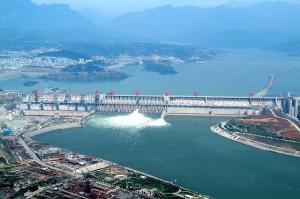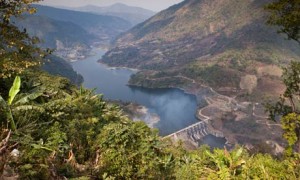
The Three Gorges Dam on the Yangtze River in China,the largest dam in the world
photo: thehimalayanvoice
China has announced it is to go ahead with building three dams on the river Brahmaputra (Tsangpo in Tibet), which originates in the Tibetan plateau near Lake Manasarovar. This announcement, as part of their 12th Five Year Plan, has caused grave concern among the north-eastern states of India, as well as political analysts and environmentalists.
The Indian government is worried that the states of Arunachal Pradesh, Bihar and Assam may be affected by drought, famine and over-flooding in the monsoon season. Minister of Water Resources Mr Harish Rawat has said in the Rajya Sabha (or the upper house of the Parliament of India), that as a lower riparian state with established user rights, India has conveyed its views to China and urged it to ensure that the interests of downstream states are not harmed by any activity in the upstream area. China’s president Xi Jinping has assured India that the proposed dams are run-of-the-river hydro-electric projects and will neither store water nor adversely affect the downstream flow to India.
India and China do not have any water sharing agreements, but instead have instituted a mechanism to exchange data on trans-border rivers. Though India has been pressing China to engage in an inter-governmental dialogue or treaty to deal with water issues, China is unwilling to consider the proposal, and worryingly, is not keen to share hydrological data either.
Political analysts feel that once China has control over the river, it can lead to diplomatic strong-arming, and may be a trigger for war. Though China claims that the dams are being built for power, analysts feel that there may be a hidden agenda.
Besides India, Thailand, Laos, Vietnam and Cambodia have expressed similar concerns over eight dams being constructed on the Mekong river which have decreased the water reaching their nations. The Chinese dam in western Xinjiang has caused the water level in two of the main rivers of Kazakhastan – the Irtysh and Ili to go down.
Environmentalists are very concerned as deforestation in the Brahmaputra Watershed Area has already resulted in increased siltation levels, flash floods and soil erosion. Global warming is causing the glaciers on the Tibetan plateau to melt, and this could make the Brahmaputra a seasonal, rather than a perennial river.
According to an article in the Guardian dated 10 August, it is not just China but also India, Nepal, Bhutan and Pakistan who are largely responsible for creating potential environmental disaster in the Himalayan region. Taken together, these four countries have plans for more than 400 hydro dams to provide 160,000MW of electricity, to be built on various Himalayan rivers. The same article states that China is likely to emerge as the ultimate controller of water for nearly 40% of the world’s population as the Tibetan plateau is the source of the single largest collection of international rivers in the world including the Mekong, the Brahmaputra, the Yangtse and the Yellow rivers.
According to Indian geopolitical analyst, Brahma Chellaney, “China is engaged in the greatest water grab in history. Not only is it damming the rivers on the plateau, it is financing and building mega-dams in Pakistan, Laos, Burma and elsewhere and making agreements to take the power.” According to Chellaney, India is in the weakest position because half its water comes directly from China.
There have been no studies regarding about the human impact of the proposed dams. India has displaced millions of people due to huge dam projects such as the Narmada dam project in the past, and so has China with the Three Gorges project.
Furthermore, as the plateau heats up due to global warming and glaciers melt at a fast rate, rivers such as the Brahmaputra and Mekong will have reduced water flow by 2050, and analysts say this would lead to further regional disputes and tensions.







 Print
Print Email
Email